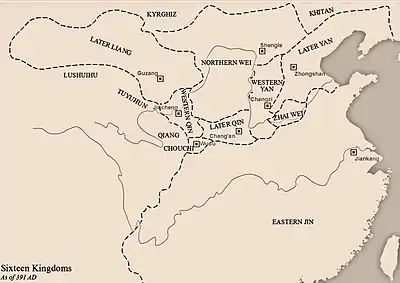Zhai Wei
Wei (Chinese: 魏; pinyin: Wèi), known in historiography as Zhai Wei (Chinese: 翟魏), was a dynastic state of China ruled by the Dingling people that existed from 388 to 392, during the Sixteen Kingdoms period of Chinese history. Its founder Zhai Liao had previously been vacillating between being a vassal of the Later Yan, Western Yan, and Eastern Jin dynasties, and in 388, after his last overture to reconcile with Later Yan's emperor Murong Chui was rejected, he founded his own dynasty, over the territory of modern central and eastern Henan. In 392, Zhai Wei, then under Zhai Liao's son Zhai Zhao, was destroyed by Later Yan forces. Because of its relatively small size and short lifespan, Zhai Wei is not included by historians among the Sixteen Kingdoms.
Wei 魏 | |||||||||
|---|---|---|---|---|---|---|---|---|---|
| 388–392 | |||||||||
 Zhai Wei in 391 AD | |||||||||
| Status | Kingdom | ||||||||
| Capital | Huatai | ||||||||
| Government | Monarchy | ||||||||
| Tian Wang | |||||||||
• 388-391 | Zhai Liao | ||||||||
• 391-392 | Zhai Zhao | ||||||||
| Historical era | Sixteen Kingdoms | ||||||||
| 387 | |||||||||
• Established | 388 | ||||||||
• Disestablished | 392 | ||||||||
| 393 | |||||||||
| |||||||||
| Today part of | China | ||||||||
The rulers of Zhai Wei used the title "Heavenly King" (Tian Wang).
Rulers of Wei
| Personal name | Reign | Era names |
|---|---|---|
| Zhai Liao | 388–391 | Jianguang (建光) 388–391 |
| Zhai Zhao | 391–392 | Dingding (定鼎) 391–392 |
Family tree
| Zhai Wei family tree | |||||||||||||||||||||||||||||||||||||||||||||||||||||||||||||||||||||||||||||||||||||||||||||||||||||||||||||||||||||||||||||||||||||||||||||||||||||||||||||||||||||||||||||||||||||||||||||||||||||||||||||||||||||||||||||||
|---|---|---|---|---|---|---|---|---|---|---|---|---|---|---|---|---|---|---|---|---|---|---|---|---|---|---|---|---|---|---|---|---|---|---|---|---|---|---|---|---|---|---|---|---|---|---|---|---|---|---|---|---|---|---|---|---|---|---|---|---|---|---|---|---|---|---|---|---|---|---|---|---|---|---|---|---|---|---|---|---|---|---|---|---|---|---|---|---|---|---|---|---|---|---|---|---|---|---|---|---|---|---|---|---|---|---|---|---|---|---|---|---|---|---|---|---|---|---|---|---|---|---|---|---|---|---|---|---|---|---|---|---|---|---|---|---|---|---|---|---|---|---|---|---|---|---|---|---|---|---|---|---|---|---|---|---|---|---|---|---|---|---|---|---|---|---|---|---|---|---|---|---|---|---|---|---|---|---|---|---|---|---|---|---|---|---|---|---|---|---|---|---|---|---|---|---|---|---|---|---|---|---|---|---|---|---|---|---|---|---|---|---|---|---|---|---|---|---|---|---|---|---|---|
| |||||||||||||||||||||||||||||||||||||||||||||||||||||||||||||||||||||||||||||||||||||||||||||||||||||||||||||||||||||||||||||||||||||||||||||||||||||||||||||||||||||||||||||||||||||||||||||||||||||||||||||||||||||||||||||||
See also
References
- Theobald, Ulrich. "Chinese History - Dingling 丁零". chinaknowledge.de. Retrieved 2015-11-09.
- Historical Dictionary of Medieval China, p. 119, at Google Books